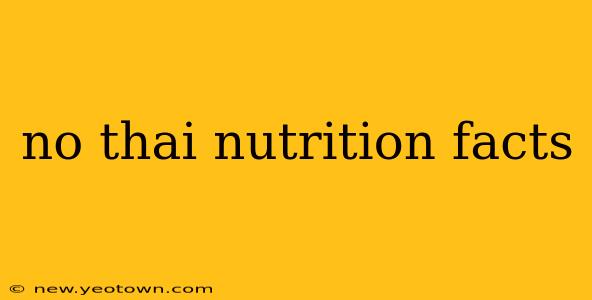Thai food. Just the words conjure up images of vibrant colors, aromatic spices, and tantalizing flavors. From fiery curries to refreshing salads, the cuisine is incredibly diverse. But what about the nutritional facts? Let's embark on a culinary journey, uncovering the nutritional landscape of this beloved food. This isn't just about calories; we'll explore the good, the bad, and the delicious in Thai dishes.
What are the common ingredients in Thai food and their nutritional value?
The foundation of Thai cuisine lies in fresh ingredients, brimming with nutritional benefits. Rice, a staple, provides carbohydrates for energy. However, the type of rice—jasmine, brown, or sticky—influences its nutritional profile. Brown rice, for instance, boasts more fiber than its white counterpart. Then there are the vegetables— vibrant peppers, aromatic lemongrass, pungent ginger, and crunchy beans— all packed with vitamins and antioxidants. Proteins come from lean meats like chicken and fish, tofu, or shrimp, offering essential amino acids. Coconut milk, while creamy and indulgent, adds healthy fats, but moderation is key due to its calorie density. Finally, the medley of herbs and spices—cilantro, basil, galangal—contribute to flavor and potentially offer anti-inflammatory properties.
Is Thai food healthy?
The healthfulness of Thai food hinges greatly on the specific dish and its preparation. A stir-fry bursting with vegetables and lean protein is a nutritional powerhouse. It's a fantastic source of vitamins, minerals, and antioxidants. On the other hand, a rich, creamy curry laden with coconut milk and sugar can be high in calories and saturated fat. The key lies in making informed choices. Opt for dishes featuring plenty of vegetables, lean proteins, and less coconut milk. Request dishes to be prepared with less oil or sodium.
How many calories are in a typical Thai dish?
This is highly variable. A simple Pad See Ew with chicken might clock in around 600-800 calories, while a richly sauced Massaman curry could easily surpass 1000 calories. Portion size plays a significant role. Appetizers, like spring rolls, can add extra calories, as can sugary drinks.
What are some healthy Thai food options?
The beauty of Thai cuisine is its adaptability. Prioritize dishes focusing on:
- Lean Proteins: Chicken, fish, tofu, or shrimp are excellent choices.
- Abundant Vegetables: The more the merrier! Choose stir-fries or curries loaded with greens, peppers, and other colorful veggies.
- Brown Rice: Opt for brown rice over white rice for added fiber.
- Reduced Coconut Milk: Ask for less coconut milk in creamy curries, or choose dishes with lighter broths.
- Fresh Herbs and Spices: These add incredible flavor and potential health benefits.
What are some unhealthy Thai food options?
Be mindful of:
- Fried Foods: Spring rolls, satay, and other fried dishes are high in calories and unhealthy fats.
- Dishes Heavy in Coconut Milk: While coconut milk offers some benefits, excessive consumption contributes to high calorie and saturated fat intake.
- Sugary Sauces and Drinks: Many dishes incorporate sugar in their sauces, and sugary drinks add extra unnecessary calories.
- Excessive Sodium: Some Thai dishes can be high in sodium, so be mindful of your intake.
Are there any Thai dishes that are low in calories?
Yes, absolutely! Many lighter dishes exist, such as:
- Som Tum (Green Papaya Salad): This refreshing salad is typically low in calories and high in vitamins.
- Larb Gai (Minced Chicken Salad): A flavorful salad with lean protein.
- Tom Yum Soup (with less coconut milk): This spicy soup is packed with flavor and can be relatively low in calories, especially when prepared with less coconut milk.
The key to enjoying Thai food healthily is making conscious choices. By focusing on fresh ingredients, lean proteins, and mindful portion sizes, you can savor the vibrant flavors of Thailand without compromising your health. Remember to ask questions when ordering – don't be afraid to request modifications to tailor your meal to your dietary needs. Bon appétit!

